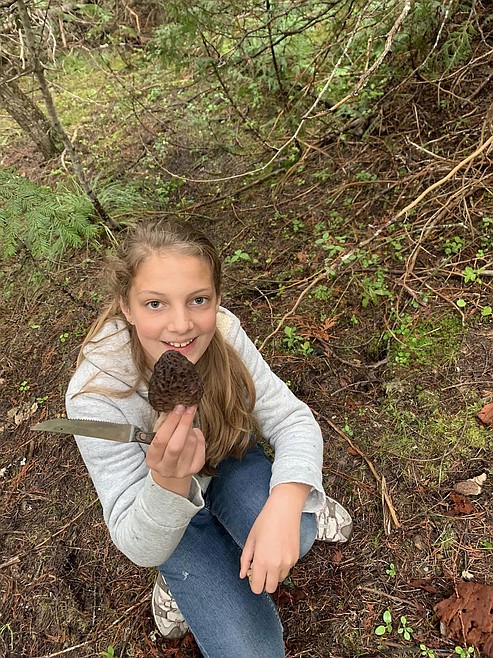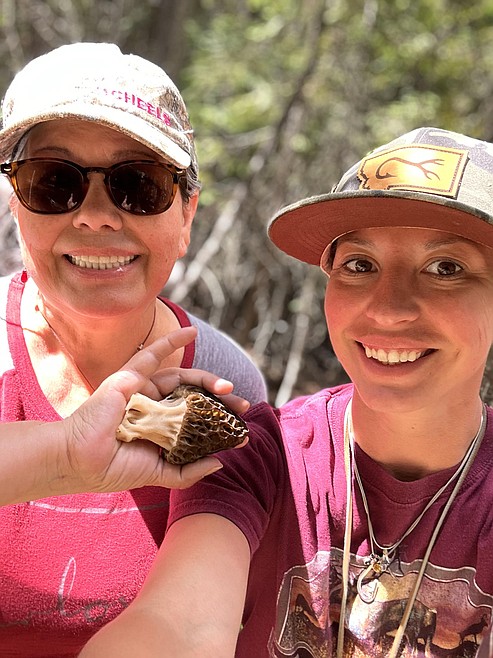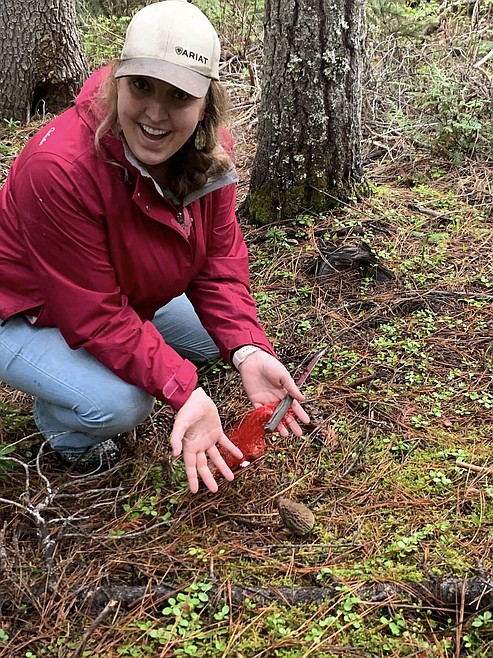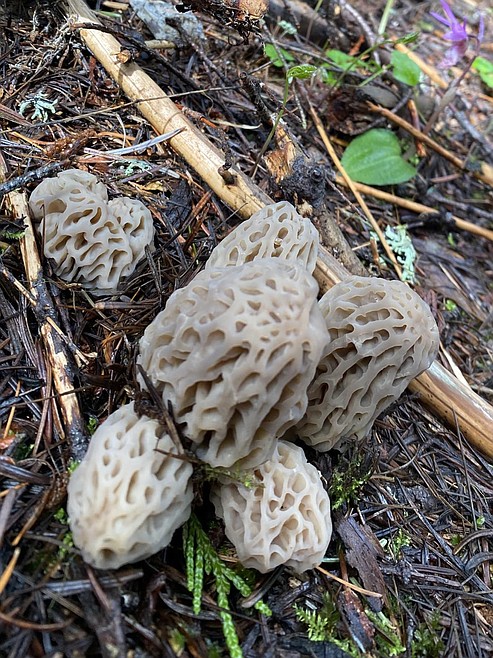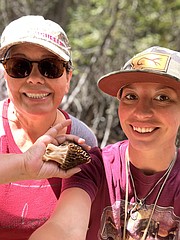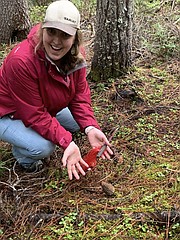Northwest Montana pickers prowl for wild morels
Nothing motivates people to scour the deep dark woods and examine the forest floors more than the annual hunt for Morel mushrooms.
Morchella, the true morels, is a genus of edible sac fungi closely related to anatomically simpler cup fungi in the order Pezizales. These distinct fungi have a honeycomb cap and come in a variety of shapes, sizes and colors.
Morels are wild mushrooms with a subtle earthy, smoky, sweet and nutty flavor. They have a meaty texture, unlike the slimier qualities of other mushroom varieties. These mushrooms are a highly desired ingredient among chefs and mushroom enthusiasts, and surprisingly these prized woodland nuggets can be found just about in any state.
But here in Montana, between the months of March and June, mushroom lovers head for the hills, recent burns and damp wooded environments to find these tasty morsels. One former Mineral County resident and amateur mycologist, Kelsey Fenn, has spent many years foraging fungi and the most coveted morels.
“I certainly wouldn’t call myself an expert in the world of mushrooms,” remarked Fenn. “However locally — I currently reside in Libby — I often have novice pickers come to me for advice. I feel very confident in being able to identify about three dozen different sorts of edible and non-edible species of mushroom relative to our area. I’ve come to appreciate, understand and frequently utilize important identification tactics — scent, spore print, feeling the caps, inspecting the stems for veils or lack thereof, and so forth.”
Growing up around St. Regis, Fenn and her sisters spent countless hours exploring the woods.
“We frequently went shed hunting, fishing, looking for gophers, going for drives, going rifle hunting, etc," she said. "At that time, we would keep an eye out for shaggy manes and morels.”
When Fenn became more passionate about foraging and mushrooms, she said, “I grabbed several highly regarded identification books. I made sure to take lots of pictures of mushrooms I wasn’t familiar with in the field to study later. I joined ID and edibility discussion groups on social media. And in order to feel the most confident in my journey, I’ve chosen to study two to three new kinds of mushrooms every year.”
Peak morel season in Northwest Montana is generally late spring to mid-summer.
“The key factors in when the season starts and ends are soil temps and what sort of precipitation is taking place,” Fenn noted.
As for where to look while morel hunting, she added, “The perhaps easiest and most common place folks go to find morels are at burn locations. The season following a burn is the best but with mint environmental conditions, it’s not unheard of to find them two, even three seasons following. Something about major soil disruption also seems to be key, they can often be found in new clear cuts as well.”
There are over a dozen known types of morels in North America. Fenn explained that, “Many have a symbiotic relationship with several sorts of trees, look around old orchards, near sycamores, hickory, ash, or elm trees. Remember, all mushrooms like moisture, so keep that in mind while you find places to scout.”
And If pickers are getting skunked and not finding many morels, Fenn advised to check the elevation.
“Early season they will be lower, as the spring goes on, they will be higher," she said. "A morel will grow to a choice size in a matter of a day or two, so check back in your choice spot a week or so after your first try.”
As pickers harvest them, Fenn continued, “Don’t worry yourself about plucking versus cutting them, it’s a myth that one way or the other prevents or ensures the continuation of them. Mushrooms spread through spores, not their stems. Keep your eyes peeled for other mushrooms, and have fun picking!”
A word of caution to novice pickers, in Montana and other states, there are a handful of deadly mushrooms. Fenn mentioned, “As well as others that can cause some serious GI issues, and even more that are technically edible but don’t taste great and/or are difficult to eat. I personally have about two dozen types of mushrooms I pick and eat in Northwest Montana.”
A challenging part of hunting for morels is coming across the sometimes-deadly counterparts – false morels.
“There are several types of mushrooms the novices call false morels," Fenn said. "Most commonly seen are those within the Gyromitra family. They tend to be more of a rusty red, off-brown color and look as though they were squished. The stem will not be hollow, sometimes they will have cottony fiber-looking insides.”
Though some false morels can be edible if prepared in a precise manner, she suggested pickers “stick with what you know until you have more experience in being able to properly identify.”
Fenn detailed, “A true morel has the semi-pointed honeycomb cap we are all familiar with. The stem is hollow when cut in half, and will always be within the shades of white, cream or light yellow.”
Whether pickers search for these fabulous fungi for the thrill of the hunt, the flavor, or for potential profit, morel pickers are busy this time of year.
Fenn concluded, “The popularity of morels can be traced back to a lot of different things but I think most obvious being they are very easy to identify and are among the best tasting edible mushrooms out there!”
Avid morel hunter Rebekah McGuffey and her daughter Piper enjoy scavenging for mushrooms around St. Regis and Superior. McGuffey gets out, “as much as I can. This year has just been a couple of times. We like to go after dinner. My daughter Piper and I will sneak away for an hour and get enough for a meal and we always set aside some to share with my mother-in-law, Lawana. She exclaimed, “Piper loves hunting for them but isn’t a fan of the flavor…yet!”
Her mother-in-law makes a delicious creamy soup with the morels and in years past McGuffey has harvested enough to freeze and use later in the winter for meals. She keeps her favorite picking grounds under wraps, however. McGuffey admitted, “I go to the same four spots, but I’m always looking when I’m in the woods. As long as I keep finding them there, I will go back.”
Another St. Regis resident, Sandra Connor, goes out every couple of days to forage. She detailed, “I pay attention to the weather pretty closely as I’m planning my days out in the woods. Knowing your mushrooms, and the environment they thrive in will help a lot.”
Of course, her honey holes are kept to herself. Connor noted, “But I do try and tell people to study what mushroom they are after because with the right research, you can find all the clues you need to get you to your mushrooms. What kind of trees do they like, temperatures, elevations, other things they sprout/bloom with, are a few specifics one should know.”
Connor’s family likes to eat them fresh, dipped in butter and flour then fried flour. They use them in eggs for breakfast, in gravies and spaghetti.
“I also dry them, so I can rehydrate them for later uses,” she added.
“I harvest what I need, and I get a little extra for my family and neighbors that are no longer able to get out in the woods."
And seasoned morel hunters know that when they discover a big growth it’s like hitting the jackpot.
Mushrooms are considered a forest product, so various types of permits both personal use and commercial use, may be required for collection over a designated amount. Permit information is online at www.fs.usda.gov.
Once pickers put in the effort to find and forage the treasured mushrooms, keep fresh morels cool and dry. Once home, store them in the refrigerator in a dry container, paper bag or wrapped in wax paper. They’ll last about a week in the fridge. Morels can also be dried for future eating, and once they’re dehydrated, store them in a plastic bag.

